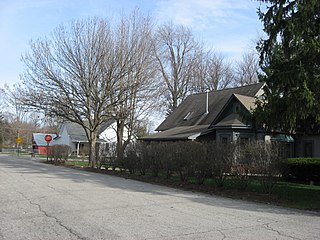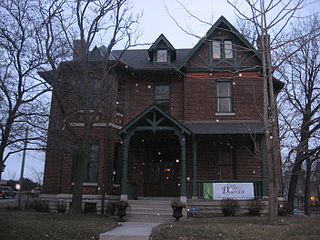
Chatham–Arch is a neighborhood located immediately east of Downtown Indianapolis, Indiana, United States. This neighborhood is one of the oldest in Indianapolis, dating back to the mid 19th century. Chatham–Arch contains many of Indianapolis's historic homes.

The Elwood Downtown Historic District is a national historic district located at Elwood, Madison County, Indiana. The district encompasses 51 contributing buildings and 1 contributing object in the central business district of Elwood. It developed between about 1887 and 1952, and includes notable examples of Late Victorian, Romanesque Revival, Neoclassical, and Art Deco style architecture. Notable buildings include the Calloway Block, Dehority Block (1894), St. Joseph Catholic Church (1899), United Methodist Church (1899), U.S. Post Office (1911), Carnegie Library (1901), former Elwood City Hall (1899), the Leeson's Building, and the Opera House.

The Greensburg Downtown Historic District is a national historic district located at Greensburg, Decatur County, Indiana. It encompasses 67 contributing buildings and 3 contributing objects in the central business district of Greensburg. The district developed between about 1854 and 1945, and includes notable examples of Italianate, Queen Anne, and Classical Revival style architecture. Located in the district are the separately listed Decatur County Courthouse and Knights of Pythias Building and Theatre. Other notable buildings include the Palmer Building, YMCA (1915), City Hall (1874), U.S Post Office, George E. Erdmann Building (1908),.

Columbus Historic District is a national historic district located at Columbus, Bartholomew County, Indiana. It encompasses 574 contributing buildings and 1 contributing sites in the central business district and surrounding residential areas of Columbus. It was developed between about 1850 and 1930, and includes notable examples of Federal and Italianate style architecture. A number of commercial buildings feature locally manufactured cast iron and pressed metal components. Located in the district are the separately listed Bartholomew County Courthouse, Columbus City Hall, and First Christian Church. Other notable buildings include the First National Bank, The Crump Theatre (1889), Reo Theater, Ulrich Bakery, Samuel Harris House (1853), Keller House (1860), Old Post Office (1910), Franklin Building, Gent Mill, First United Presbyterian Church (1871-1885), Irwin Block, Irwin Home and Gardens, and St. Batholomew's Roman Catholic Church (1891).

Courthouse Historic District is a national historic district located at Logansport, Cass County, Indiana. The district encompasses 79 contributing buildings and one contributing site in the central business district of Logansport. It has a mix of institutional, governmental, and commercial buildings and notable examples of Late Victorian and Romanesque Revival style architecture. Notable contributing resources include the Masonic Hall (1896), Elks Lodge No. 66 (1907), Douglass Building, McCaffey Building, Logansport-Cass County Public Library (1942), The State Theater, United States Post Office (1925), Bank Building, and Watts Building (1901).

Brazil Downtown Historic District is a national historic district located at Brazil, Clay County, Indiana. The district encompasses 35 contributing buildings and two contributing objects in the central business district of Brazil. The district developed between about 1875 and 1935, and includes notable examples of Italianate, Romanesque Revival, and Renaissance Revival style architecture. Located in the district is the separately listed United States Post Office. Other notable buildings include the Sinclair Oil Gas Station, Lark Theater, Citizens Bank Building, Brazil Trust Company, D.H. Davis Building (1909), and Telephone Building.

Washington Commercial Historic District is a national historic district located at Washington, Daviess County, Indiana. The district encompasses 88 contributing buildings and 1 contributing object in the central business district of Washington. The district developed between about 1815 and 1940, and includes notable examples of Italianate, Federal, and Classical Revival style architecture. Located in the district is the separately listed Daviess County Courthouse. Other notable buildings include the City Hall (1916), Temple Court (1894), Peoples National Bank (1928), Masonic Building, Indiana Theater, American Steam Laundry Building, Baltimore and Ohio Passenger Depot (1906), Westminster Presbyterian Church (1911), and U.S. Post Office (1916).

Goldsmith C. Gilbert Historic District is a national historic district located at Muncie, Delaware County, Indiana. It encompasses 75 contributing buildings and is located in the oldest residential section of Muncie. The district includes notable examples of Late Victorian, Colonial Revival, and Bungalow / American Craftsman style architecture. Located in the district is the separately listed J.C. Johnson House. Other notable buildings include the A.L. Johnson House, Meeks Mortuary Building, Joseph Hummel House, and Miller Livery (1916).

Wysor Heights Historic District is a national historic district located at Muncie, Delaware County, Indiana. It encompasses 61 contributing buildings, 1 contributing site, and 1 contributing object in a predominantly residential section of Muncie. The district developed between about 1890 and 1930, and includes notable examples of Queen Anne, American Foursquare, and Bungalow / American Craftsman style architecture. Notable contributing resources include the equestrian sculpture and landscape ensemble "Appeal to the Great Spirit" by Cyrus Edwin Dallin (1929), Roy Thomas House (1922-1923), Burt Whiteley House (1892), and the first Delaware County Children's Home building.

Old West End Historic District is a national historic district located at Muncie, Delaware County, Indiana. It encompasses 273 contributing buildings in a predominantly residential section of Muncie. The district largely developed between about 1880 and 1915, and includes notable examples of Late Victorian style architecture. Notable buildings include Temple Beth-El (1922), First Church of Christ Scientist, Wittmore Apartments, Martin Sisters House (1879-1880), Christian Church / Wesleyan Chapel (1875), Vandercook House (1887), First English Lutheran Church, Muncie Hospital and Invalids Home (1890), and Ira Hunter House.

Westwood Historic District is a national historic district located at Muncie, Delaware County, Indiana. It encompasses 83 contributing buildings and 1 contributing site in a predominantly residential section of Muncie. The district developed after 1923, and includes notable examples of Colonial Revival, Tudor Revival, and Bungalow / American Craftsman style architecture. Notable buildings include the William H. Ball House (1925), Alexander Bracken House (1937), Michael Broderick House (1928), Bennett Heath House, and Fred Kencht House (1932).

Riverside Historic District is a national historic district located at Muncie, Delaware County, Indiana. It encompasses 74 contributing buildings and 1 contributing structure in a predominantly residential section of Muncie. The district developed between about 1895 and 1949, and includes notable examples of Colonial Revival, Tudor Revival, and Bungalow / American Craftsman style architecture.

Meeks Avenue Historic District is a national historic district located at Muncie, Delaware County, Indiana, USA. It encompasses 25 contributing buildings in a predominantly residential section of Muncie. The district developed between about 1904 and 1939, and includes notable examples of Bungalow / American Craftsman style architecture. A notable building is a service station constructed in 1939.

Kirby Historic District is a national historic district located at Muncie, Delaware County, Indiana. It encompasses 25 contributing buildings in a predominantly residential section of Muncie. The district developed between about 1839 and 1930, and includes notable examples of Greek Revival and Colonial Revival style architecture. Notable buildings include the Thomas Kirby House (1839), William F. Spencer House (1909), John Fitzgibbons House (1918), Theopharia A. Hough House (1909), Pearl Hopkins House (1893), and Edward R. Templar House (1905).

Elkhart Downtown Commercial Historic District is a national historic district located at Elkhart, Elkhart County, Indiana. The district encompasses 59 contributing buildings in the central business district of Elkhart. It was developed between about 1868 and 1930, and includes notable examples of Italianate, Queen Anne, and Classical Revival style architecture. Located in the district are the separately listed Green Block, Lerner Theatre, and Young Women's Christian Association. Other notable buildings include the Cornish Block, Franklin Street Station (1895), Menges Building (1908), former Post Office (1905), Midwest Museum of Modern Art (1922), Elkhart Water Company, Masonic Temple, Rowe Block (1900), and Dreves Building.

Goshen Historic District is a national historic district located at Goshen, Elkhart County, Indiana. The district encompasses 751 contributing buildings and 1 contributing site in the central business district and surrounding residential sections of Goshen. It was developed between about 1840 and 1930, and includes notable examples of Italianate and Queen Anne style architecture. Located in the district are the separately listed Elkhart County Courthouse and Goshen Carnegie Public Library. Other notable buildings include the Kindy Block (1881), Central Block (1882), Spohn Building (1909), Harper Block (1888), Noble Building, Jefferson Theater (1907), General Baptist Church (1859), First Methodist Church (1874), and St. James Episcopal Church (1862).

Marion Downtown Commercial Historic District is a national historic district located at Marion, Grant County, Indiana. It encompasses 52 contributing buildings, 2 contributing structures, and 1 contributing object in the central business district of Marion. It developed between about 1870 and 1942, and includes notable examples of Italianate, Romanesque, and Classical Revival style architecture. Located in the district is the separately listed Grant County Jail and Sheriff's Residence. Other notable buildings are the Grant County Courthouse (1881-1883), Marion Bank Building, Iroquois Building, Dan-Mar Apartments, United Telephone Block, Cecelian Apartments, Marion Post Office, and William Smith Building / Mecca Club.

New Augusta Historic District is a national historic district located at Indianapolis, Indiana. It encompasses 114 contributing buildings, 1 contributing structure, and 1 contributing object in a railroad oriented village in Indianapolis. The district developed between about 1852 and 1939, and includes representative examples of Italianate and Bungalow / American Craftsman style architecture. Notable contributing buildings include the Odd Fellows Building, Hopewell Evangelical Lutheran Church, Salem Lutheran Church (1880), and New Augusta Depot. It is located west of Augusta.

Virginia Avenue District is a national historic district located at Indianapolis, Indiana. The district encompasses 43 contributing buildings and 1 contributing structure in the Fountain Square Commercial Areas of Indianapolis. It developed between about 1871 and 1932, and notable buildings include the Sanders (Apex) Theater (1913), Southside Wagon and Carriage Works / Saffel Chair Company, Fountain Square Theater (1928), Woessner Building, Granada Theater (1928), Southside Theater (1911), Schreiber Block (1895), Fountain Square State Bank (1922), and Fountain Bank (1902).

St. Joseph Neighborhood Historic District is a national historic district located at Indianapolis, Indiana. The district encompasses 57 contributing buildings in a predominantly residential section of Indianapolis. It was developed between about 1855 and 1930, and include representative examples of Italianate and Queen Anne style architecture. Located in the district are the separately listed Bals-Wocher House, William Buschmann Block, Delaware Court, Pearson Terrace, and The Spink. Other notable buildings include the Christian Place complex, Fishback-Vonnegut-New House, Henry Hilker House, Apollo-Aurora Rowhouses, Israel Traub Store, and Lorenzo Moody House.
























